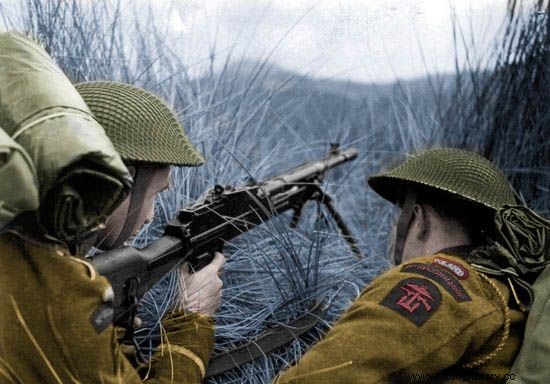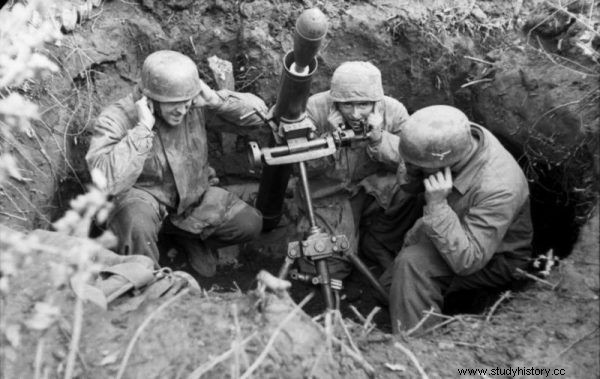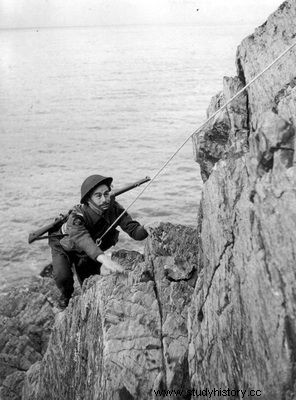Commandos are cool guys, such an army I understand ... - said a captain of the 2nd Polish Corps, seeing the perky soldiers of the 1st Independent Commando Company. This elite unit for special tasks was constantly making fights and smashing allies in the bars. Now she was about to launch an assault on Monte Cassino.
It was August 1942. For two years, the British were creating their famous commando formations, when finally the Poles decided to show them that they can do the same - only better. General Władysław Sikorski gave the order to form a Polish company Commando.
It was included in the 10th Interalian Commando. The Polish unit consisted of two rifle platoons and a command platoon and totaled 114 people.

The commander of the Polish commandos, Władysława Smrokowski (on the right) with General Anders.
Among them were many veterans of the campaigns in Poland, France, Norway, as well as the civil war in Spain. It even included a few former soldiers of the Foreign Legion and volunteers from both Americas. The commander was then Capt. Władysław Smrokowski, distinguished by his bravery, participant in the September campaign and the battle for France.
There's nothing like practicing with your brothers in arms!
The training of the Polish Commando company was carried out at the special units training center in the Scottish Achnacarry. There Poles exercised, among others, deep forays into the rear of the enemy combined with long-term survival in the field, handling various types of weapons, including enemy weapons, hand-to-hand combat, rowing, sailing and climbing.
Much emphasis was placed on the improvement of the so-called "Silent work" with a knife. It is also worth adding that half of the soldiers underwent parachute training. 
How professional the training was is evidenced by an incident in one of the Scottish pubs. Several commandos fought there with Polish artillerymen who hated them and who had a significant advantage in numbers.
The showdown ended was weird to say the least. The police called for intervention not only did not punish the commandos with arrest or fines, but even ordered them to place the defeated opponents along, not across the pavement, so as not to block the passage. There is nothing like British pedantry and Polish hot blood!
In September 1943, the Poles were transferred to Algeria, where the soldiers were supposed to catch the survivors of the German and Italian armies. By the way, taking advantage of the proximity of the Tellski Atlas, they perfected their tactics in the mountains.
As the future was to show, it was very useful in Italy. So far, the rebellious nature of Poles, who were clearly bored in Africa, made themselves felt. They suffered several scandals with a combat-alcohol-knife scandal, and in Philippeville they fought a victorious battle with the soldiers of the Royal Irish Guard. But all that is good comes to an end. On December 1, 1943, the company landed in Taranto, Italy, where it was assigned to the 2nd Commando Brigade.

The training of Commando units was really murderous. The soldiers practiced everything that could be useful to them later in carrying out dangerous missions behind enemy lines. As it turned out, such a test was invaluable in bar fights as well.
It then joined the British 78th Infantry Division and took up a position on the Sangro River. There, on the night of December 21-22, out of 80 Poles stationed in Pescopenantaro, 200 German mountain shooters were struck. Polish commandos repelled the attack with the loss of only three wounded, killing or injuring thirty Germans in the process .
A stone against a Nazi and Poland has not died yet!
In April 1944, the 1st Independent Commando Company was incorporated into the 2nd Polish Corps. Capt. Smrokowski was promoted to major. The unit has also received the necessary additions.
The first operation of the Polish commandos in the composition of General Anders' corps was the Battle of Monte Cassino. At that time, there were 15 officers and 72 privates in the company. According to the guidelines of the corps commandos, just before the first Polish attack on the night of May 11/12, 1944, they were to penetrate the German lines and eliminate the observation points on the Monte Cairo towering over the area. However, this action was canceled, and the soldiers of the Commando company had to wait another week for their combat debut.
The main task of the Polish commandos in the second attack on Monte Cassino was to capture the Colle Sant'Angelo hill. The company, operationally subordinate to the 5th Kresowa Infantry Division, was reinforced with an assault squadron of the 15th Poznań Uhlans Regiment, thus creating the Commando Group, commanded by Major Smrokowski.

After a long and exhausting training and several months' stay in Tunisia, on December 1, 1943, Polish commandos arrived on the Apennine Peninsula (color:RK).
At Colle Sant'Angelo, the Poles had to face the elite of the German army - units of the 1st Parachute Rifle Division. It was a tough, demanding opponent. As he emphasizes in his book "Monte Cassino. Hell of Ten Armies ”Peter Caddick-Adams, they were people:
trained for landing and small group combat with limited resupply [...], underwent training aimed at increasing resilience, resourcefulness and acting without orders and dealing with overwhelming adversities .
And the situation of Poles during the first assault?
On the slopes of Colle Sant'Angelo due to the lack of ammunition and one more counterattack, one leading company [Poland] started throwing stones at the Germans while singing the Polish national anthem for added spirit (Peter Caddick-Adams "Monte Cassino. Hell of Ten Armies").
Hill of decaying bodies
Sant'Angelo is dotted with lots of huge stone bunkers. Added to this are the so-called pillboxes, i.e. small steel prefabricated bunkers armed with heavy machine guns. In addition, there are German snipers among the rocks, and the entire area is within the range of German artillery and mortars.
Both parties still remember a detail that accompanied them in their struggle for the Mountain of the Angel of Death, as the Poles called Colle Sant'Angelo. It was… the smell of swarming flies, decaying and rotting bodies in the heat. Quoted by Peter Caddick-Adams, the German paratrooper Capt. Kurt Veth mentioned that his soldiers were forced to wear gas masks because the stench of the bodies of the dead was unbearable in the hot May sun .

Polish commandos at Monte Cassino had to face elite parachute shooters.
In such a hell our commandos had to attack side by side with ordinary infantry. The Commando grouping, like the other units of the 2nd Corps, starts its assault on May 17 at 7.00 a.m. On the hill, 706 Poznań attack squadron comes under the murderous fire of German artillery. 12 wounded are unable to continue fighting.
After the ranks are in order, the Poles attack again. In the afternoon a change of orders comes:Major Smrokowski's group is to first protect the wing of the 16th Lviv Rifle Battalion, which was attacked by the Germans, and only then to strike the northern part of Sant'Angelo together with the 17th Lviv Rifle Battalion.
About 13.00 commandos lie under heavy fire from enemy machine guns. There are many wounded. Despite all the dread of the situation, there are also some tragicomic episodes. Sergeant Saberowski receives a shot from a sniper in the corner of his eye and nose.
See if the bullet came out of the back of my head - asks the cadet. Silk.
The other one replies instantly:- You moron, if you had a hole you would be dead!
Polish infantry is bleeding heavily at Sant'Angelo
Around 4 p.m. Poles strike Sant'Angelo again. The soldiers from the 13th, 16th and 17th Rifle Battalion, supported by commandos, are attacking. In total, this gives a force equal to one battalion.
This time, the Poles, despite the heavy fire of German mortars, manage to occupy part of the hill. However, Germany is still firmly at the top. The oncoming night brings the fight to a halt. You can review and reorganize the bloodied Polish ranks. At the end of the day, Commando's status is 11 officers and 54 privates.

A sketch showing the battlefield for Monte Cassino through Polish eyes, with the Mount of the Angel of Death marked.
After midnight, two Germans with a red cross flag come to the Polish positions, asking for the possibility of evacuating the wounded. As a result of the agreement, 21 wounded German paratroopers are sent to the rear.
When at 9.40 am on May 18, the Podolish lancers enter the ruined monastery, the Mountain of the Angel of Death is still in German hands. At 10.00, the Polish attack starts again and is repulsed again just before the summit. German paratroopers fight stubbornly. They are convinced that Poles are not taking prisoners.
Commandos and drivers. Hand in hand against Germany
Major Smrokowski managed to establish contact with the commander of the attack, Col. Rudnicki. Smrokowski reports that the Commando Group suffered heavy losses. For 36 hours he has been fighting without water, and people are at the end of their tether. Colonel Rudnicki orders to persevere. Smrokowski confirms that he will carry out the order.

The fights in Italy showed that the commando climbing training was very useful on the battlefield.
At 4:20 pm, Polish soldiers pick up one more attack. Apart from commandos and Poznań lancers, also soldiers from the remnants of the Rifle Battalions depleted the day before are attacking. Col. Rudnicki also leads a reserve force:
composed of division anti-tank and anti-aircraft regiments, spare drivers and military police, and everyone else who could hold the rifle (Quote from:Peter Caddick-Adams "Monte Cassino. The Hell of Ten Armies").
For an hour and a half the fate of the battle tilts back and forth. German artillery joins the action again. Poles are flooded with a hail of flying rock fragments. The number of injured is increasing.
Even though the reserve forces were stalled, the commandos took over almost the entire peak of Sant'Angelo by 7:30 PM. Half an hour later, a report appears that the Germans are withdrawing, and a strong, fortified outpost has been erected on the captured crest of the hill. On May 19, 1944, two white rockets rise above the Mountain of the Angel of Death, drawing a symbolic V sign in the sky.
